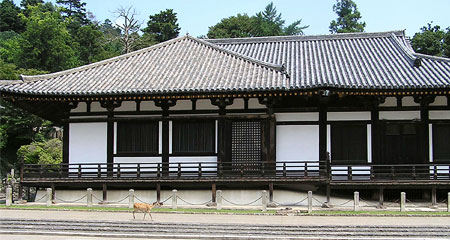|
||
 |
||
1 A meditation hall based on a plan that allows circumambulation around a statue. The statue of the bodhisattva *Fugen 普賢 (Sk. Samantabhadra) is the most usual image around which the circumambulation is constructed, but the historical Buddha *Shaka 釈迦 (Sk. Sakyamuni) or *Amida 阿弥陀 may also be the main images. The purpose of walking continually around the statue is to concentrate on the Lotus Sutra HOKEKYOU 法華経 seeking ultimate truth. A particularly famous Hokkedou is the one at Toudaiji 東大寺, Nara, popularly called the Sangatsudou 三月堂. However, the existing structure includes the original Hokkedou (mid-8c) and the Raidou 礼堂, the worship hall for laymen, originally built in 1199, but connected to the Hokkedou in 1264. The entire structure is now 5 x 8 bays. The Hokkedou is 4 x 4 bays square: between this and the 5 x 2 bays raidou are 5 x 2 bays called *tsukuriai 造合, the place where the two downwardly inclined roofs are joined. The Hokkedou has a hipped roof *hougyou-zukuri 宝形造 while the raidou has hip-and-gable roof *irimoya-zukuri 入母屋造. The entrance is on the gable end of the raidou. It is presumed that a separate building existed as a worship hall in the Nara period so that the two buildings were like a *narabidou 双堂 (two separate structures of equal length), but not of equal depth, placed one in front of the other.
2 An ossuary *noukotsudou 納骨堂 for the remains of aristocrats.

Toudaiji Hokkedou 東大寺法華堂 (Nara)
(C)2001 Japanese Architecture and Art Net Users System. No reproduction or republication without written permission.
掲載のテキスト・写真・イラストなど、全てのコンテンツの無断複製・転載を禁じます。

